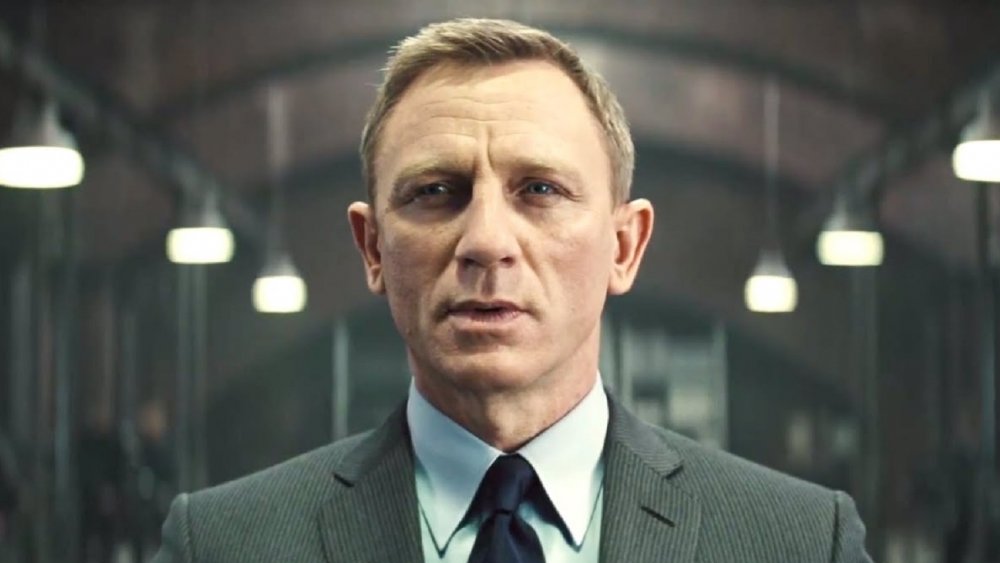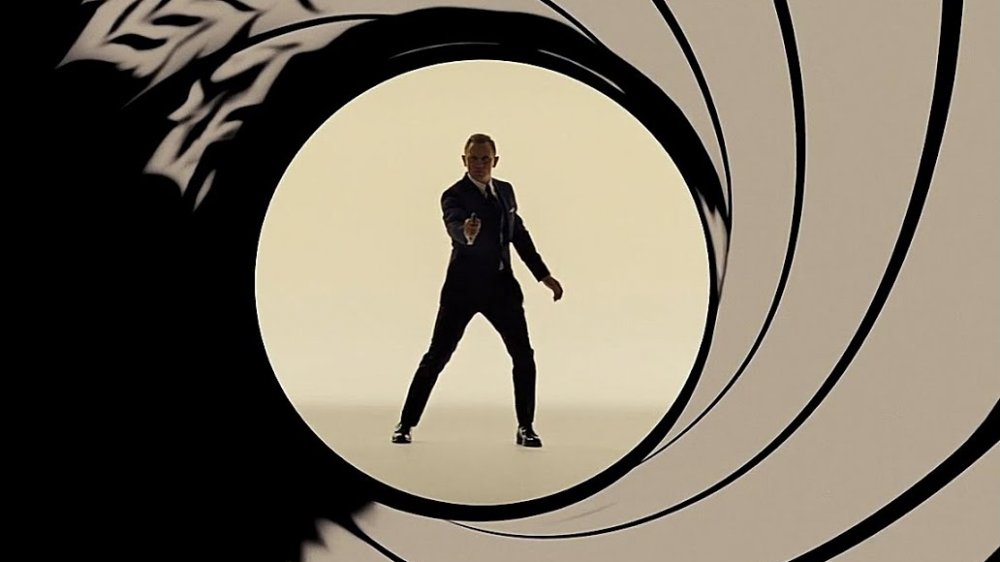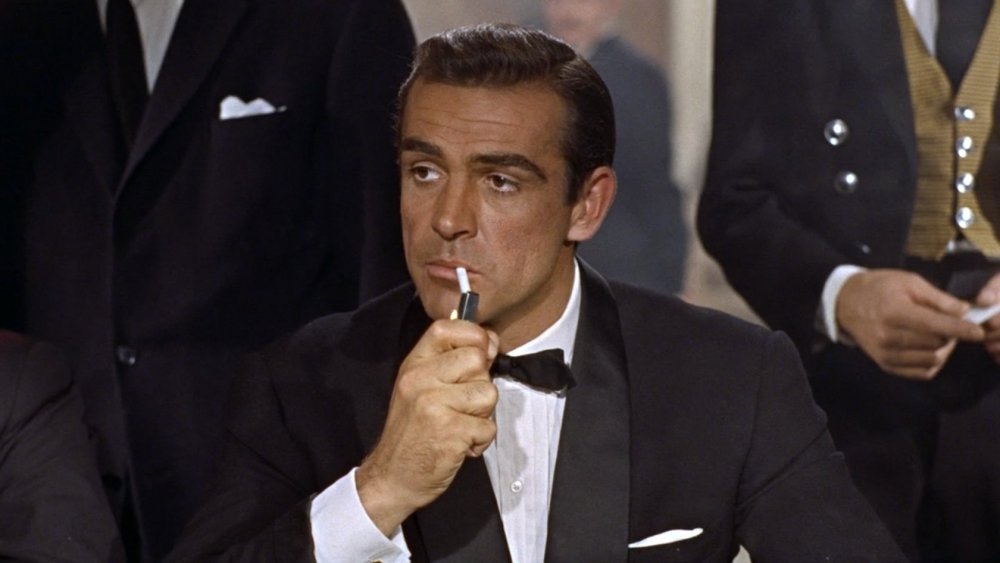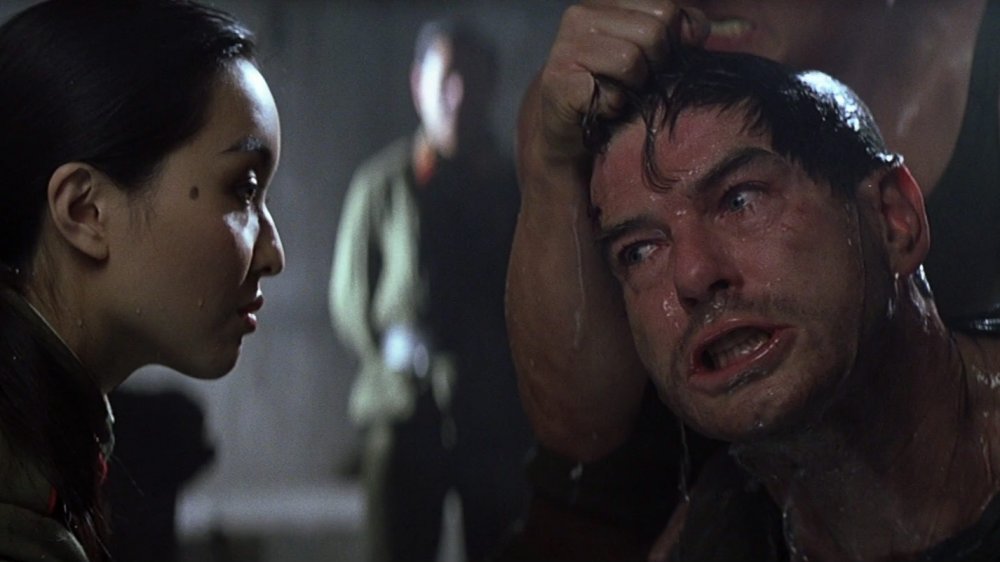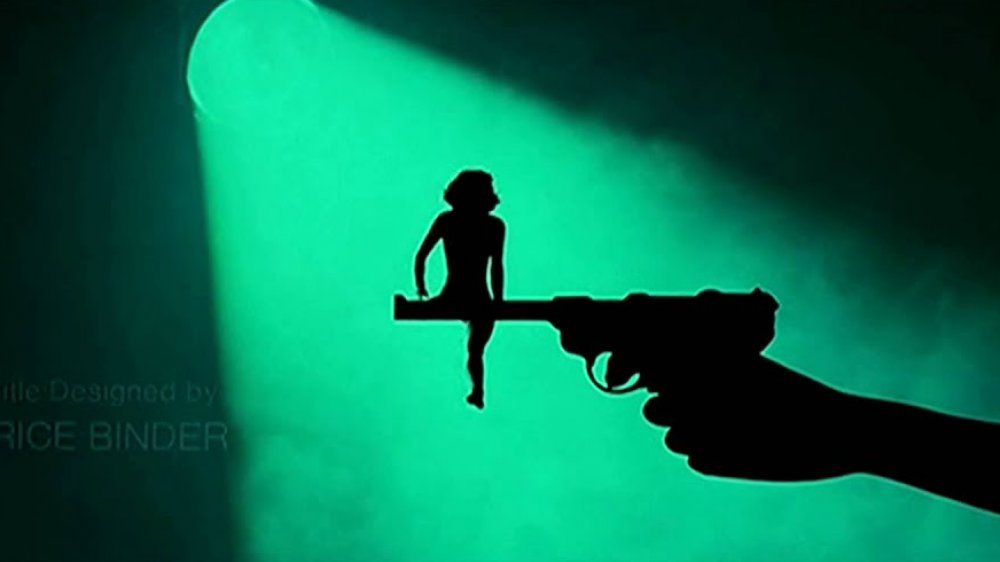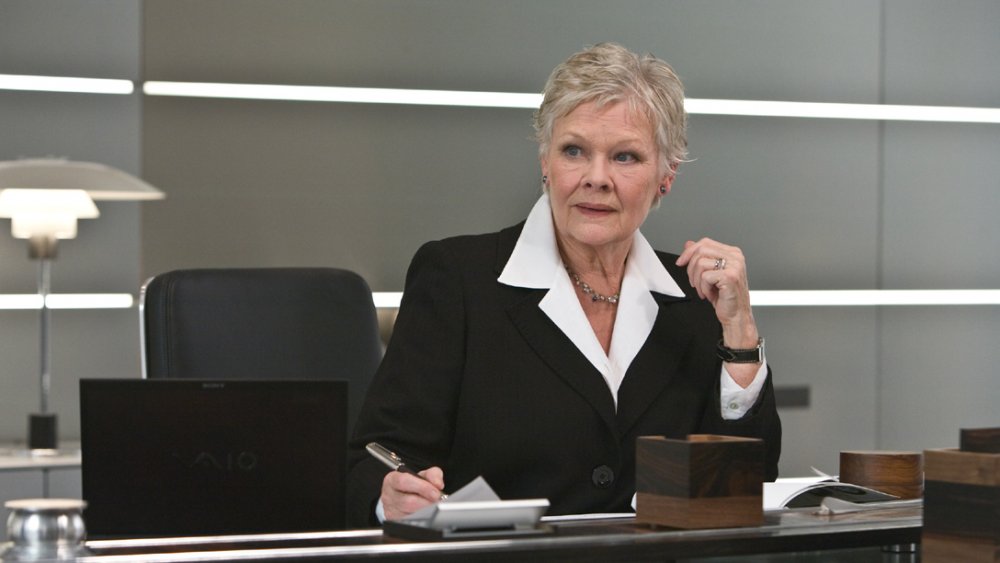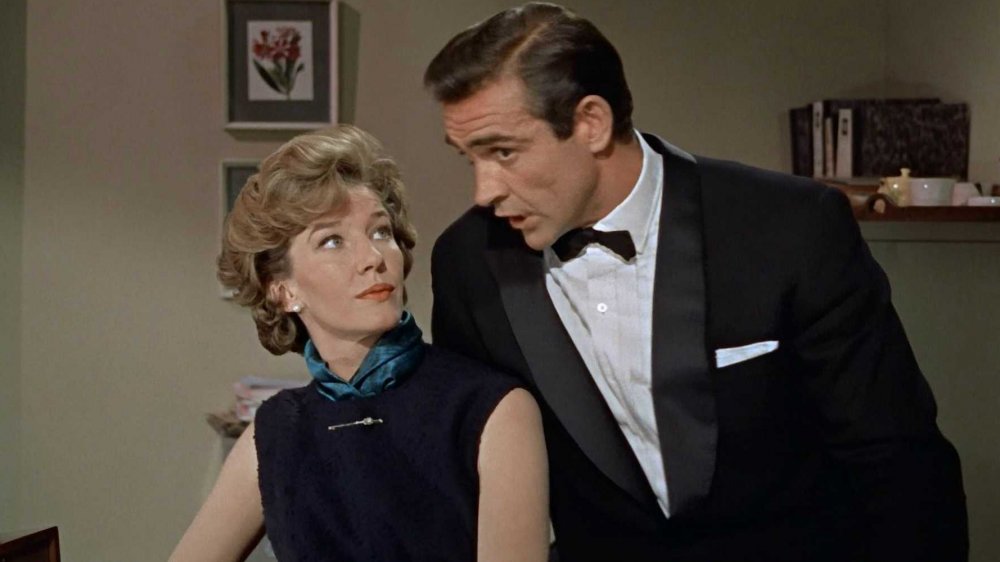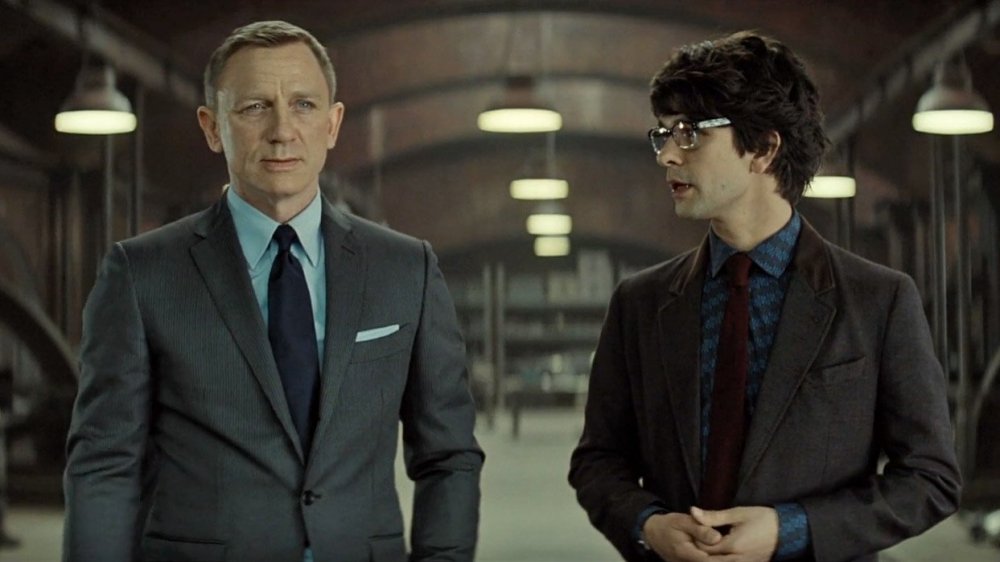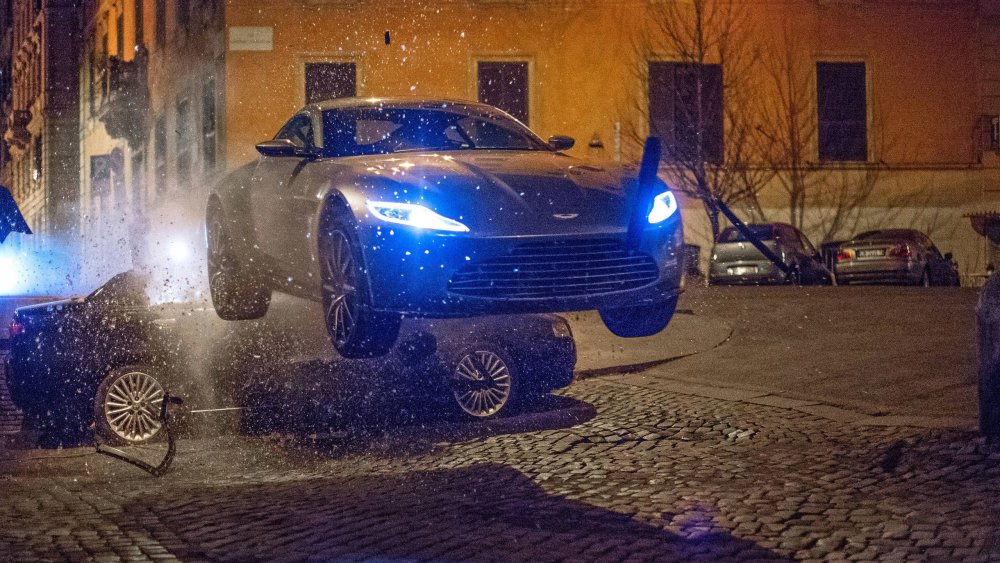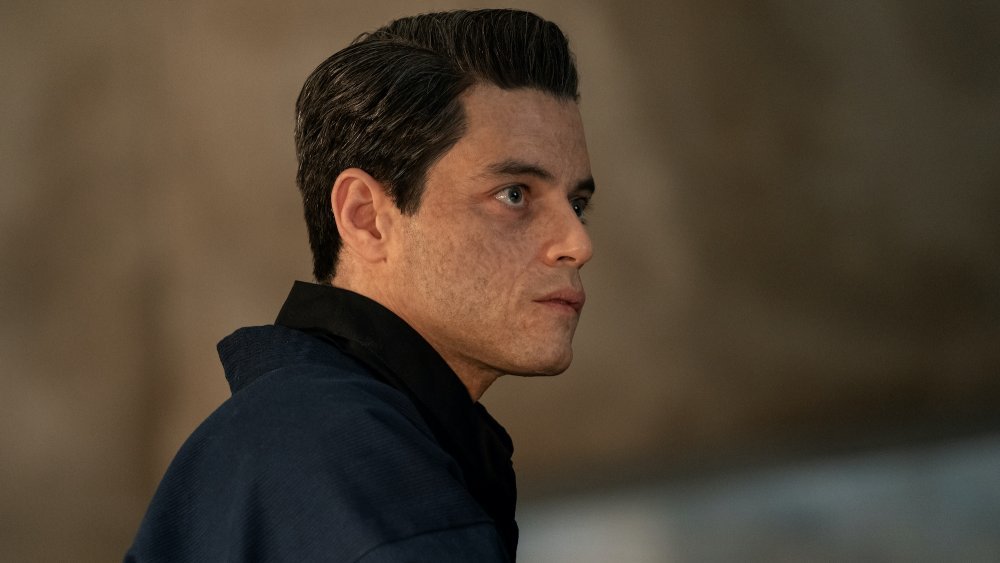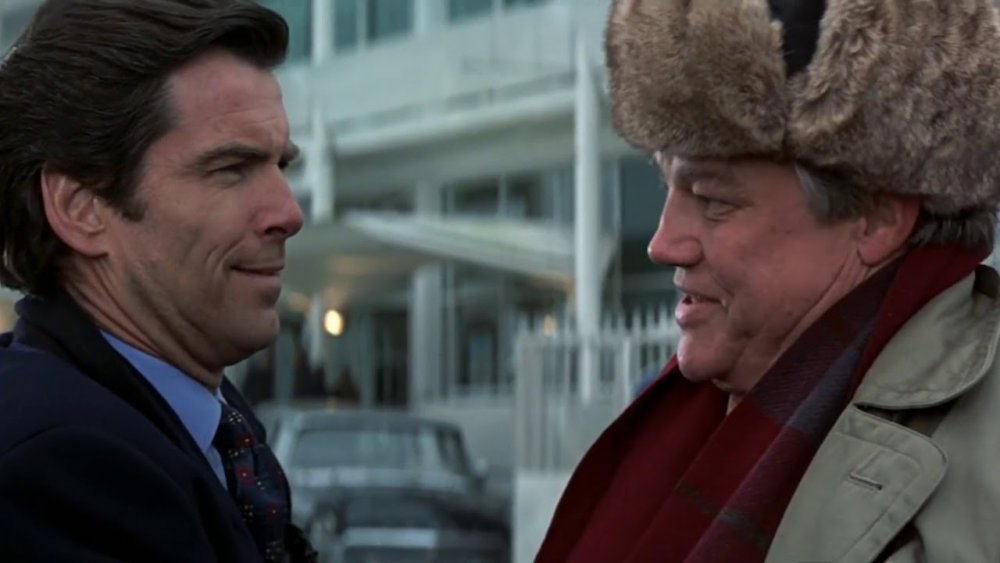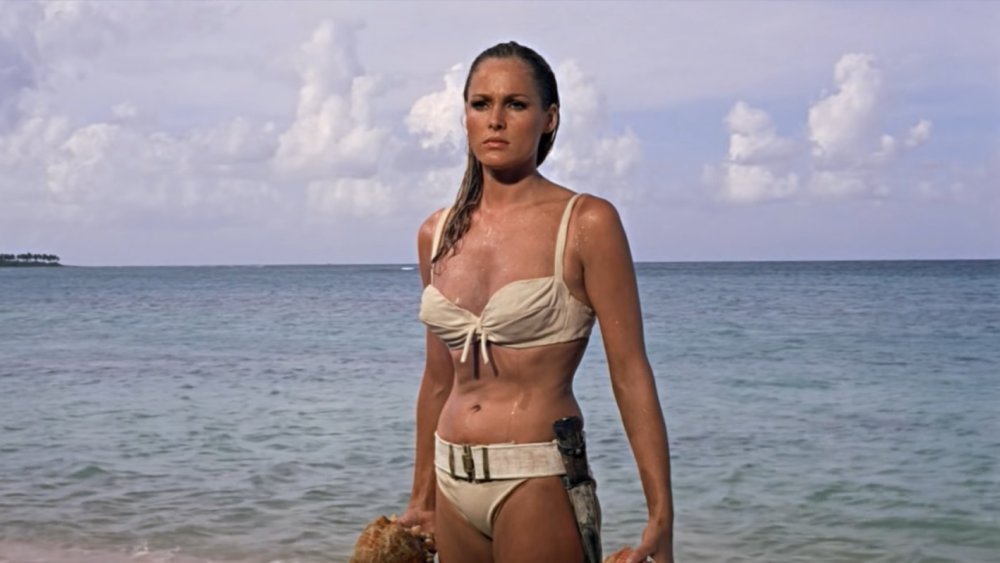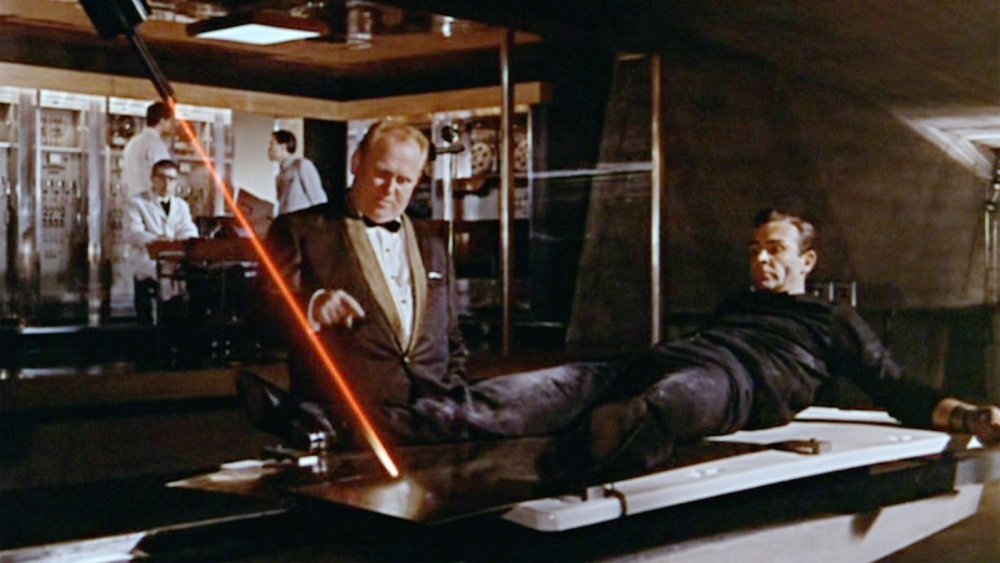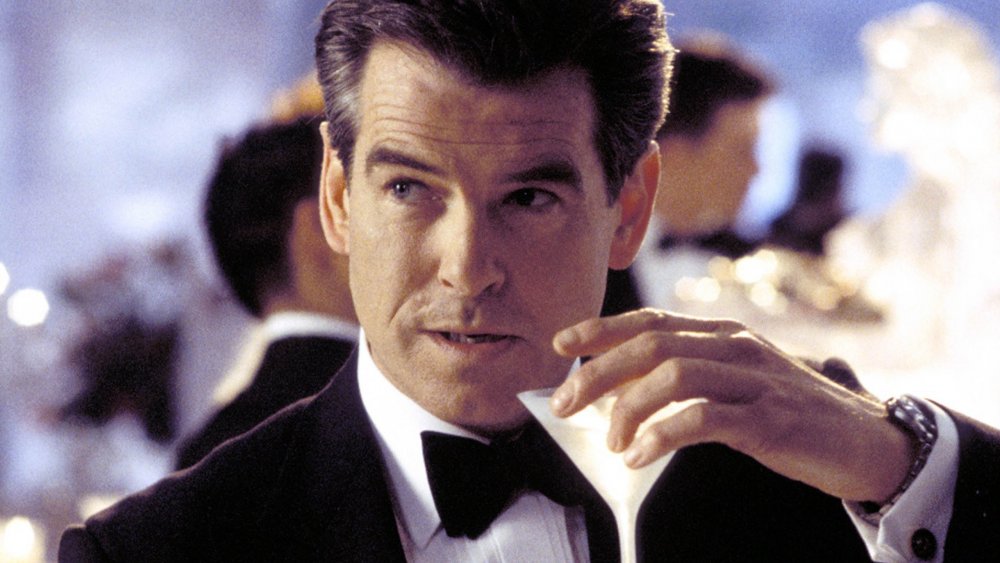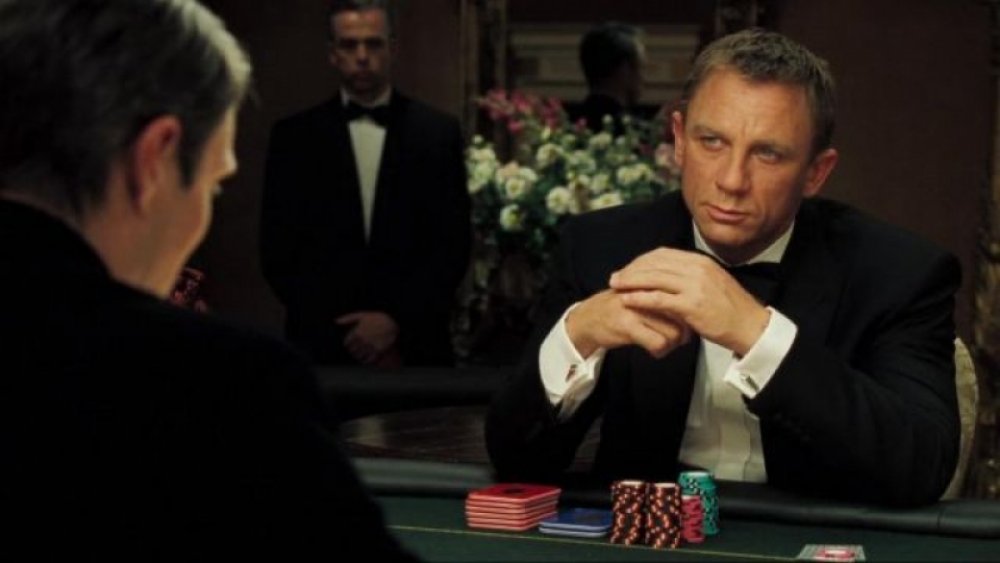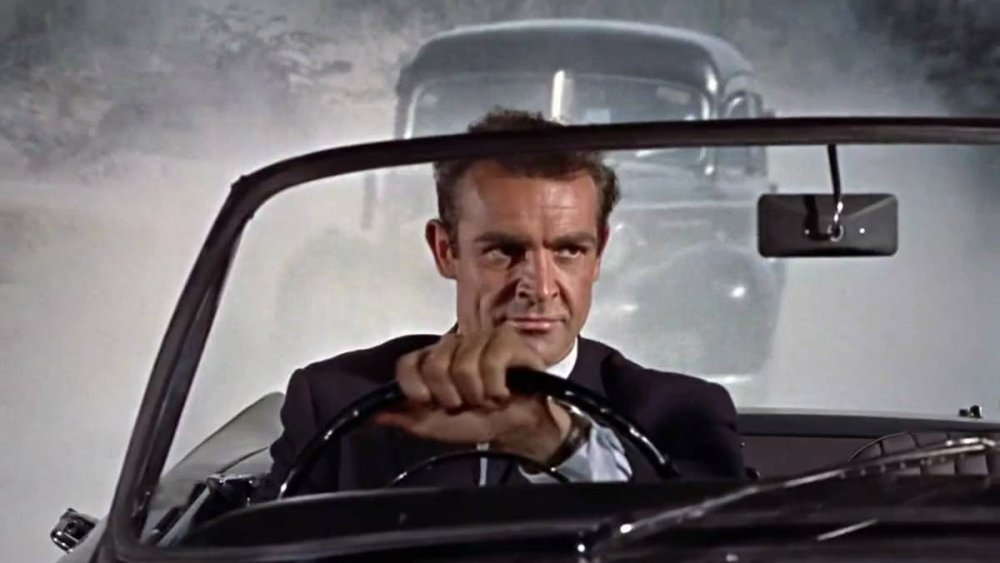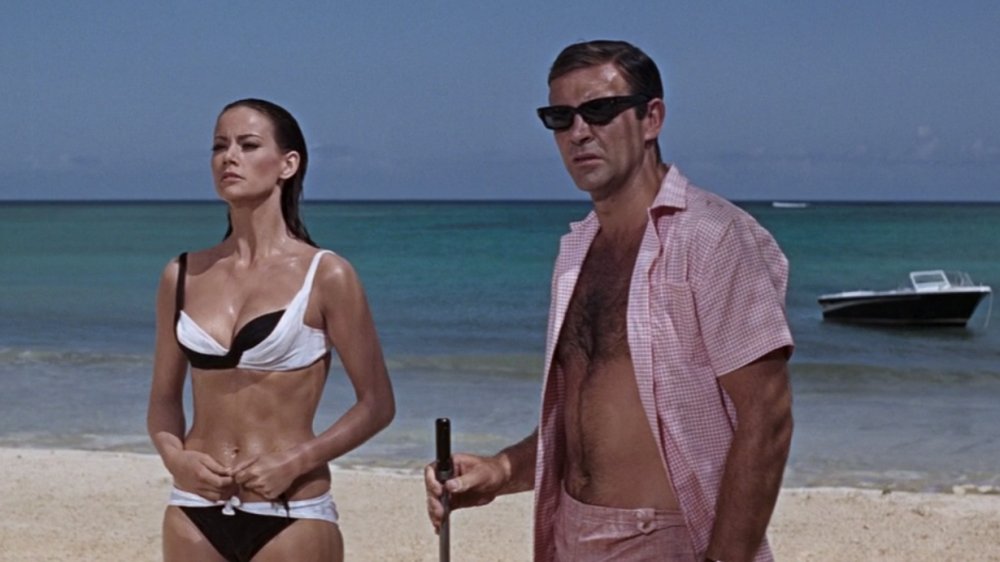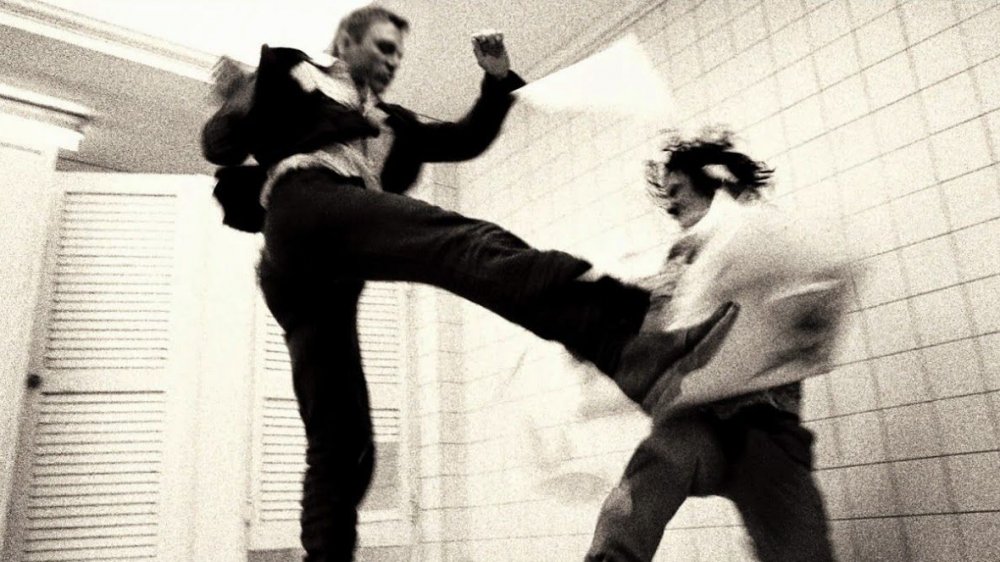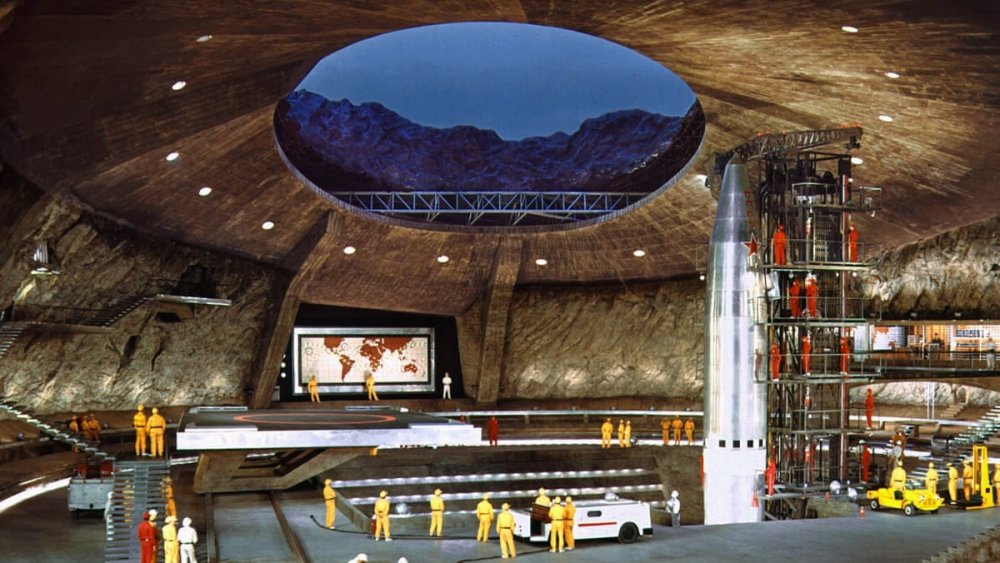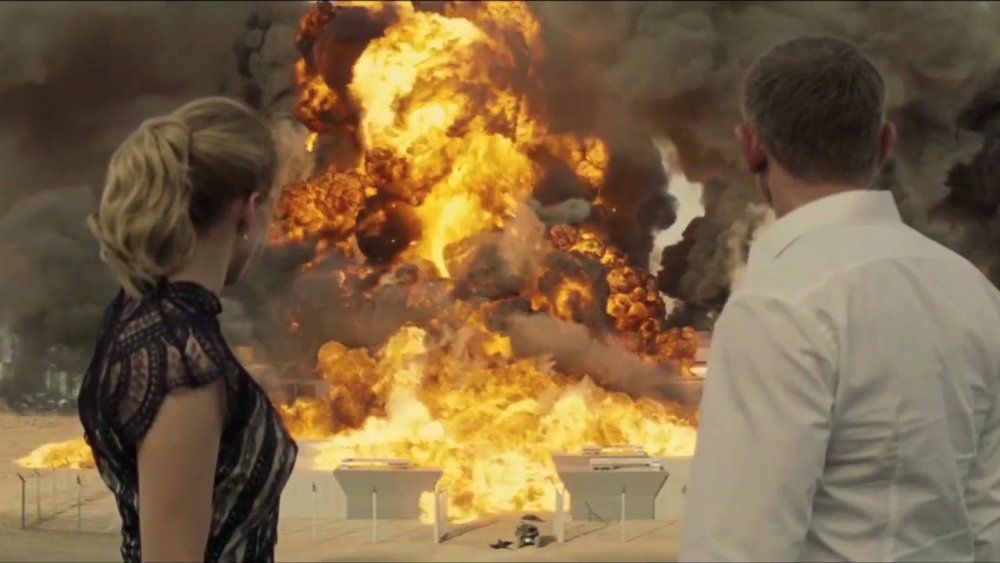These Things Happen In Every Bond Movie
Successful franchises achieve greatness, in part, because they give a sense of familiarity to their audience. We're talking about recurring themes, inside jokes, tropes, and motifs that give a franchise a particular flavor. And one of the best examples of that is the James Bond universe. Despite having over 20 movies spanning six decades — movies that are created by different filmmakers and contain various actors — Bond films still retain recurring elements that make them, well, Bond-esque.
Even if you're not a hardcore Bond fan, you still know that the line, "The name is Bond, James Bond," is classic 007. And that's what we're touching on in this article. From Bond girls to Q's gadgets, these are the things we see and expect in every Bond movie. If you're a Bond film enthusiast, you probably already know some of these motifs, and you'll be pleasantly reminded of them. But maybe you'll also learn about a few that you've never noticed before.
Nearly every Bond movie has the opening gun barrel sequence
Few things are more quintessential Bond than the gun barrel sequence. Nearly every Bond film has a version of this opening. The camera has the perspective of an assassin, ready to shoot our beloved protagonist, James Bond. Cooler still, the camera appears like it's inside the barrel of the gun, aiming right at Bond. Typically, Bond walks across the screen, then suddenly turns and shoots the assassin dead. Depending on which variation you're watching, blood may fall on the screen and the gun barrel will wobble. Then it typically goes into the Bond theme song and the pre-credit scene.
This trope debuted in the first Bond film, Dr. No, but interestingly, it doesn't feature actor Sean Connery. The very first gun barrel sequence uses stuntman Bob Simmons. Originally, the shot was meant to only be a silhouette of 007, but viewers can clearly see the actor isn't Connery. Since then, the sequence has evolved with each Bond actor providing his own rendition. Sometimes, they tweak the color and aspect ratio, and sometimes, the Bond actor does a slightly different movement, but it's always the same format — an assassin tries to shoot Bond, but Bond gets the jump on him.
'Bond, James Bond' is classic 007
Without a doubt, the most famous line from the Bond universe is, "Bond, James Bond." Usually, someone will say these three words within the first 15 minutes of the film. As with so many of our themes here, this catchphrase started in the first Bond film, Dr. No. Sean Connery introduced 007 to the cinematic world with these words, and ever since then, it's just stuck. Technically, it's Connery's second line in the movie, but it's the one that counts.
It's such a simple phrase, but it captures so much of Bond's personality. It's classy. It's mysterious. It's sexy. And it probably helps that Connery delivered it flawlessly. The quote was so popular that future Bond films included versions of it. To mix things up a little bit, the line is sometimes stated in unusual ways. For example, in Thunderball, a villain named Fiona Volpe says the line mockingly. And in Goldfinger, James Bond is interrupted when he tries to say it, which was the writer's way of teasing the audience that they weren't going to hear it that time around.
The Bond films love their pre-title teasers
Before a Bond film introduces the movie's title and credits, it must first show a pre-title teaser. It's a brief sequence, and while sometimes it's connected to the rest of the film's plot, other times, it's totally unrelated. These sequences usually show Bond in some exciting or suspenseful scenario. For example, in Die Another Day's pre-title sequence, Bond infiltrates a military base, but his cover is blown, and he's captured and tortured.
The pre-title sequence is kind of like an opening act to get viewers hyped up for the main story. It's the appetizer before the main course, so to speak. These moments almost always include an impressive stunt on the part of the Bond actor or stunt double, such as the scene where 007 leaps off a giant dam in GoldenEye. The pre-title sequence originated with the first Bond film, and it's been a staple ever since. It usually lasts five to seven minutes, although there are exceptions, such as The World is Not Enough's pre-title sequence, which runs at almost 15 minutes.
There's got to be a trippy title sequence with music
Whether you think they're annoying or amazing, you've got to admit, Bond films go all out on their title sequences. They typically last a solid two minutes as they introduce the film's title, actors, and creators. And for reasons that only the Bond gods know, the title sequence is always super trippy. They have swirling images, silhouettes of women in provocative positions, flashing lights, and strange images. Plus, the title sequences will contain plot elements from their respective films. For example, in Casino Royale's title sequence, there are cards, spades, and hearts flying around, since the plot centers around a game of poker.
Along with this animation is a song by a contemporary artist, usually created specifically for the Bond movie. Paul McCartney wrote the song for the title sequence of Live and Let Die, and Adele wrote the one for Skyfall. The filmmakers put a ton of work into these sequences, and they're works of art in and of themselves. In fairness, though, sometimes they're a little too otherworldly, and they can feel like an intermission when you're wishing the movie would just start.
M gives Bond an assignment
This classic plot element shows up early in Bond films, and it's often the launching point for the entire story. As we all know, Bond works for MI6, the British counterintelligence agency. His immediate superior is M, who often has conflicting feelings about Bond. She (or he, depending on who's playing the part) recognizes his potential, but unfortunately, Bond is difficult to handle and gives her a headache whenever he does something rash (and he often does something rash). Anyway, we usually see M at the beginning of every Bond film because she has to give Bond some sort of mission, and she'll brief the spy on a mysterious incident or a dangerous figure that he must investigate.
This scene often serves as an explanation of the plot for the viewers. It lets us know who the bad guy is or what Bond must accomplish in the film. For example, near the start of Thunderball, Bond is called to a meeting. There, M explains that the evil organization SPECTRE has stolen a couple of atomic bombs and is threatening to destroy England's cities unless the British government pays up £100 million. It's then that Bond volunteers to go on a mission to discover where the bombs are hidden, and M allows it. If you want to know what's going on in Bond film, make sure you pay attention whenever M gives Bond his assignment.
Bond flirts with Moneypenny
Miss Moneypenny is M's assistant, so Bond usually runs into her whenever he visits MI6 to receive a new mission. Moneypenny was originally portrayed by Lois Maxwell in Dr. No, but since then, multiple actresses have played the part, each with a different interpretation of the character. Still, the relationship between Moneypenny and Bond has stayed consistent
The two are essentially co-workers who've come to know each other over the years, but that doesn't stop Bond from trying to seduce her, if only jokingly. It happens in passing, but aside from Casino Royale and Quantum of Solace (where Moneypenny is notably absent), Bond films always include a scene where Bond and M's assistant have a flirtatious conversation. One of their on-going inside jokes is that Moneypenny deeply loves Bond, but Bond doesn't feel the same way and only wants to sleep with her. Here's sample of their conversation from Dr. No.
Moneypenny: "You never take me to dinner looking like this. You never take me to dinner, period."
Bond: "I would, you know, only M would have me court-martialed for illegal use of government property."
Apparently, Bond and Moneypenny never made it to HR's sexual harassment training at MI6. But despite all his womanizing, Bond has never slept with Miss Moneypenny. So far, their relationship has only amounted to playful conversations and one sexy shaving scene.
Q explains a life-saving gadget to Bond
This part of the Bond film is always so freaking cool. After Bond receives his mission, he visits Q, the weapons developer for MI6. Q specializes in crafting advanced, personal weapons for MI6 agents, and after 20-plus Bond films, Q has created all kinds of awesome inventions — an invisible car, explosive eyeglasses, and smart blood (which involves nanotech that tracks Bond's moves). These gadgets are often deadly weapons disguised as normal day objects. For example, in GoldenEye, Bond receives a normal-looking pen, but if you click it and wait, it'll explode.
So, Bond will visit Q in his laboratory, and that's when the gizmo genius will introduce and explain a new toy for 007. And if a device is explained, Bond will almost certainly use that object later in the film at a critical moment, often to escape a life-threatening situation or to save someone in peril. For example, in Die Another Day, Bond is equipped with a sonic ring that shatters glass on touch, and later in the film, he uses his futuristic piece of jewelry to break a window and save a woman from drowning. No matter the Bond movie, whenever Q shows up, you know you're in for a high-tech treat.
Bond is always driving around in some super nice vehicles
If you start watching a Bond movie, you can expect at some point that you'll see an amazing vehicle. After all, James Bond loves driving insanely fast. He's the kind of guy who locks eyes with the passenger and floors it on a winding road with a drop-off cliff just inches away. Maybe the passenger panics, but Bond's pulse remains low, and he never reaches for his seat belt. And it just wouldn't be fitting for Bond to drive around like that in a beat-up, rusty car. The only appropriate thing for a man like 007 to drive is a shiny, expensive sports car. And since Bond does quite a lot of traveling, both for business and for pleasure, he's going to hop into a vehicle eventually.
But even when he's not driving around in his iconic Aston Martin, this super spy has non-traditional means of getting around. The Bond franchise has tried to mix things up over its long run by showcasing other types of vehicles — jet skis, boats, helicopters, and private planes. We even see a car that turns into a submarine, as well as another car that converts into an airplane. The Bond filmmakers have certainly been creative in their vehicle choices, but whether it's a speed boat or a flying car, there's always a nice vehicle to appreciate in the Bond films.
Always expect a larger-than-life villain with a crazy plan
What is James Bond without a wild villain? Bond baddies are always epic. Sure, the tamest ones are killers and big-time drug dealers, but your typical Bond villain builds a space station intending to wipe out humanity and start over with a "master race" (Drax in Moonraker). The average Bond villain fakes his death, radically alters his physical appearance, resurfaces as a different ethnicity, builds a space weapon, and tries to incite war between North and South Korea (Gustav Graves in Die Another Day). What we're trying to say is that Bond villains are over-the-top, larger-than-life, insane human beings. And their evil plans are about as crazy as it gets.
In the world of James Bond, bad guys build satellite weapons out of freaking diamonds, live in underwater cities that can move, and steal nuclear weapons like it's just another Tuesday. Bond villains have a presence, a philosophy, and a sense of grandeur, such as Francisco Scaramanga, who only uses a golden gun with golden bullets to kill his victims. Why, you ask? Because he's a James Bond villain, that's why. They're world-dominating, Earth-ending, behind-the-curtain geniuses with billions of dollars and a massive network of elite friends. If you pick up a Bond flick, we can almost guarantee you that the villain will be out of this world and have an insane plan.
Bond always meets with an ally
Bond does a lot of spy work on his own, but even the most independent heroes need help once in a while. At some point in your average Bond movie, Bond will hit a wall in his mission. He can't find a bad guy's location, or he doesn't have enough firepower to storm the villain's lair. Enter the ally who provides help in a time of need.
There aren't rules, per se, about Bond meeting with his ally. Sometimes, Bond reaches out to the ally, while other times, the ally is conveniently introduced in the plot. And on some occasions, Bond must temporarily ally himself with an unsavory character to accomplish his mission. For example, in GoldenEye, Bond contacts Russian mob boss Valentin Zukovsky to set up a meeting with the villainous Janus.
Two notable recurring allies in the Bond franchise are Jack Wade and Felix Leiter, both of whom are CIA operatives. Bond is on good terms with these resourceful men, and he contacts them every so often for help. Beyond that, the ally that Bond meets in a movie usually shows up for that brief moment, then completely disappears.
What's a Bond movie without a Bond girl?
Bond girls are such a quintessential element to Bond films that they've almost reached the same status as 007 himself. Whenever a new installment comes out, fans don't just ask who's playing the super spy. They also ask who's playing the Bond girl because there has to be a Bond girl. Those are just the rules.
The first Bond girl was Honey Ryder, played by Ursula Andress in Dr. No. And after she walked out of the ocean and caught 007's attention, the franchise kept going with the motif, bringing in new actresses with each film. Bond girls almost always have a sexually suggestive name, such as Pussy Galore, Holly Goodhead, or Plenty O'Toole. And there's usually at least one scene where the Bond girl is in a revealing outfit, as if she's posing for a magazine cover.
Needless to say, Bond usually winds up sleeping with the principal Bond girl. On rare occasions, Bond sometimes even falls in love with them, a la Vesper Lynd in Casino Royale. There are no set rules on how Bond girls interact with Bond. On occasion, they're his allies, playing a key role in helping Bond carry out his mission. But other times, they're enemies, in the service of the villain who Bond is fighting against.
There's always a protracted attempt to kill Bond
One of the biggest criticisms and jokes about the Bond universe is how often villains take forever to try and kill Bond. There always seems to be a moment where the bad guy has 007 in his clutches, ready to kill our hero once and for all. Of course, we know that's never going to happen because of plot armor. So the writers put Bond in a dire situation, and all hope is seemingly lost, but Bond always escapes or kills the villain at the last second.
This typically plays out in one of two ways. The first is that the villain, in all of his class, must kill Bond in an elaborate and sophisticated way. For example, Auric Goldfinger is above commanding his henchmen to shoot Bond. Instead, Goldfinger must strap Bond to a metal table, aim a laser at him, and slowly move the laser towards his body. Or when Dr. Kananga captures Bond, he tries to execute Bond by slowly lowering him into a pool with sharks.
The second way this plays out is when the villain must — must — give a long-winded speech before killing Bond. In Tomorrow Never Dies, the villain Elliot Carver gloats to our hero about how his plan will prevail. But doing so gives Bond enough time to cook up a scheme for killing Carver. These moments often prompt us to ask the obvious question — why don't villains just shoot Bond?
Everybody knows how Bond likes his martinis
Bond loves spying, womanizing, and of course, drinking alcohol. But he can be a bit picky about his beverages. Sure, he favors martinis, but they must be prepared a certain way, hence the iconic instruction, "Shaken, not stirred." In most Bond films, he usually says this line to a bartender or waiter. The line captures a snippet of Bond's personality, showing that he's confident and classy.
From the very first Bond film, Dr. No, Bond was ordering shaken martinis. In the following movies, you continue to see Bond order this favorite drink of his, as the incredibly cool catchphrase just stuck. Sometimes, Bond himself says it, but other times, someone else will say the line when ordering for him. Every so often, Bond orders his drink off-screen, and that's when the server hands him a martini, restating the instructions for the spy's approval. But one way or another, the line finds its way in most Bond films.
Bond certainly loves his humorous one-liners
Bond films are espionage action flicks to be sure, but they're meant to be fun, exciting, and light-hearted for the most part. To that end, a common motif for Bond films is humorous one-liners, often delivered by Bond himself. These one-liners often show up at otherwise dark moments in the films. For example, after killing a bad guy, Bond will deliver a witty comment that's generally a play on words. For example, in Goldfinger, Bond electrocutes a villain and then says, "Shocking. Positively shocking." Or after spearing a villain, Bond says, "I think he got the point."
Our personal favorite one-liner comes from Casino Royale. While playing poker, the villain sneaks James a poisoned drink. Bond pardons himself from the table and barely survives the poisoning attempt. After returning to the poker table, he says, "I'm sorry. That last hand ... nearly killed me." Obviously, the villain knows what Bond is implying, but everyone else thinks Bond was just saying the last hand of poker was incredibly tough.
While these one-liners add a fun spirit to the franchise, the humor also serves a dual purpose. These lines soften the blow of violent scenes. Basically, it's like the actor is telling the audience, "The violence is all just a joke."
Every Bond movie has an epic chase scene
If you're watching a Bond movie, sooner or later, you're going to see an epic chase scene. It could be Bond chasing a bad guy or the villains chasing Bond, but either way, there's going to be a dogged pursuit, and someone is going to be high-tailing it out of there.
For example, at the end of Thunderball, there's an epic boat chase involving yachts, military vessels, and a whole lot of machine guns. In Spectre, Bond chases Dave Bautista through the streets of Rome, sliding down alleyways in his super sleek sportscar. And in Casino Royale, we get to witness one of the greatest parkour moments in movie history, with Bond chasing a terrorist up and over every object imaginable. And during these thrilling sequences, we get to see how clever our hero can be, as 007 often gets the upper hand by thinking outside the box.
And yeah, things can get kinda crazy sometimes. In The World is Not Enough, he's skiing down mountains while para-gliders are trying to blow him up. And during car chase scenes, Bond's vehicle is often equipped with guns, missiles, and slippery goo. This makes for action-packed sequences that go beyond cars weaving in and out of traffic. For example, in Die Another Day, Bond and a villain have a shoot-out using their car guns while on top of a glacier. So yeah, when it comes to epic chase scenes, it doesn't get any better than a Bond movie.
These movies are full of beautiful international locations
James Bond wears sharp clothes, drives beautiful cars, and seduces gorgeous women. So it's only natural to complete the picture by placing him in breathtaking settings. It's amazing how many places Bond has visited. From the beaches of Cuba to the ski slopes of Austria, Bond always ends up in an insanely beautiful international location. He fights with a villain atop the Golden Gate Bridge, has a romantic getaway to Venice, and even goes all the way to outer space.
It comes with the job, we suppose. MI6 operates throughout the world, so naturally, the counterintelligence agency sends Bond all over the place. We're not sure why Bond doesn't fight more bad guys in his own country, and we don't really understand all the legalities that come with operating in foreign countries, but it seems MI6 is omnipresent on Earth. Granted, every so often, Bond must endure a terrible climate, like the tundra of Russia or the desert of Bolivia. But inevitably, Bond's mission will bring him to an exotic, attractive place. You can count on it.
In every Bond movie, 007 fights a bunch of henchmen
If Bond didn't fight henchmen, the sun wouldn't rise in the morning. This is a rite of passage that Bond must go through every film before facing the main villain.
And as we all know, a big baddie must have henchmen. We're not sure where these villains find such willing lackies for hire, but we hope the job comes with good healthcare because, sooner or later, James Bond is going to kick their butts. Generally speaking, the henchmen are totally worthless — they miss shots, can't throw a punch, and easily lose track of Bond. But there's usually one over-the-top henchman that causes problems, like Oddjob or Jaws.
Early in the film, the henchmen might be on the offensive. For example, the villain sometimes tries to assassinate Bond using one of their little sidekicks. But later in the movie, near the climax, the toadies are totally on the defensive. Bond always infiltrates the villain's lair and goes ham on a ton of henchmen. And while each one isn't strong enough to best Bond, a whole team of them can exhaust our hero and make his final battle with the villain more difficult.
The villain always has a secret lair
Bond villains often share some common traits — a physical deformity, a sinister plan, and a thirst for power. But no matter what, one thing every Bond villain seems to have is a secret, hard-to-reach lair.
These lairs defy physics and must take massive budgets and genius architects to create them. Gustav Graves from Die Another Day has an ice castle. Karl Sigmund Stromberg from The Spy Who Loved Me lives in Atlantis, an underwater city that can travel around. Hugo Drax in Moonraker has a space station. That isn't even mentioning the bad guys who reside in a hollowed-out volcano lair, an underground lair, or a private island lair.
Sometimes, these hangouts are situated in a beautiful location, like Blofeld's mountain top lair in On Her Majesty's Secret Service. And other times, the place is more practical, like Alec Trevelyan's train in GoldenEye. But no matter where they're located, James Bond always has a difficult time infiltrating these crazy lairs.
Bond sabotages the villain's plan
There's only one way to end a Bond movie. Bond must ruin the villain's plan. It doesn't matter if we're watching Sean Connery, Timothy Dalton, Daniel Craig, or even George Lazenby — whoever is playing 007, it's their job to stop the big bad guy from carrying out an evil scheme. Granted, our hero is going to encounter setbacks along the way, and the villain will take some truly spine-chilling precautions to keep Bond at bay, but no matter what, 007 will find a way to thwart the villain's evil plan.
In some ways, the formula is pretty predictable. But still, we wouldn't want a Bond movie to end any other way. When Dr. No uses a radio beam to disrupt missile launches, Bond destroys the radio beam. When Blofeld tries to gain control of a global surveillance program, Bond destroys his data center before it can happen. The villain may be incredibly smart, rich, and powerful, but Bond always wins in the end.
